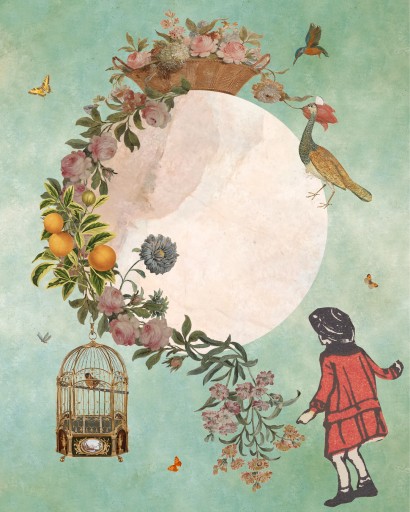The fascinating history of the Royal Łazienki gardens as a place that influences the senses and imagination is presented in the temporary exhibition ‘Life of the Royal Garden’. It is a colourful narrative about the garden’s hitherto unknown history, its social and cultural function, and the everyday life of its residents and employees.
The exhibition will be open to the public on Tuesdays and Wednesdays from 10:00 a.m. to 5:00 p.m., on Thursdays and Fridays from 10:00 a.m. to 6:00 p.m., on Saturdays from 12:00 noon to 8:00 p.m. and on Sundays from 10:00 a.m. to 4:00 p.m. Last admission is 30 minutes before closing time. Admission: PLN 30 – standard ticket, PLN 15 – discounted ticket, PLN 20 – adults with a Large Family Card, free admission on Fridays. Tickets can be purchased at the ticket office or the ticket machine in the Podchorążówka (Officer Cadet School) or online.
We invite you to Sunday guided tours of the ‘Life of the Royal Garden’ exhibition. The guides' stories, full of anecdotes and engaging commentary, will allow you to delve deeper into the history of the Royal Łazienki gardens and learn about the daily lives of their former residents. Tour dates: 24 August from 2.30 p.m. to 3.30 p.m. and 7 September from 2.30 p.m. to 3.30 p.m.
The history of the Łazieki gardens
The Royal Łazienki is renowned for its neo-classical monuments set amidst meticulously maintained historic gardens. There are three main gardens here: the Royal, Romantic and Modernist gardens. These were created in different historical periods and differ in character and style. The exhibition unveils their hitherto untold history.
Thanks to archival photographs, works of art, everyday objects and handicrafts, we will see how the garden spaces and architecture have evolved. We will discover the importance of this location for the residents of Warsaw and how it has influenced the imagination of Poles. The Łazienki gardens have been depicted in various literary and theatrical works, and have served as a setting for important meetings and events, including those of a national significance. The exhibition also presents them through the artistic medium of collages by Mirella von Chrupek, created as part of the ‘Eutopia. Miasto Niezwykłe’ project, as well as the artist’s installations as part of the exhibition’s scenography.
The people of the Royal Łazienki
The Royal Łazienki is also about the people and their significant contributions to the development and transformation of this location. The exhibition presents the creators and managers of the gardens, as well as the previously unknown biographies of former Łazienki gardeners, some of whom even had the privilege of residing within the royal residence. We will have an opportunity to gain an insight into the everyday life in the Łazienki at that time. We will take a look at archival designs of neo-classical buildings by the first architect of the Royal Łazienki, Tylman van Gameren. Thanks to illustrations from the historic Herbarium and books on the expenditure and maintenance of the Łazienki gardens dating from the Tsarist era, we will learn which plants were once cultivated here and how the gardens were tended. Drawing upon paintings and archival photographs, specialists from the Garden Department of the Royal Łazienki Museum will recreate four historic flower beds, which can be admired – as part of the exhibition – in the vicinity of the Palace on the Isle and the former Inn.
Among the exhibits intended to bring the former everyday life of the Łazienki gardens closer to visitors are historic gardening tools, including an English mechanical lawn mower dating from the first half of the twentieth century, as well as a curiosity: a nomogram, a device for drawing sundials. In a film presented at the exhibition, today’s gardeners talk about their experiences at work.
Nature in the Łazienki gardens
The exhibition also presents the nature in the Łazienki gardens. These are the plants and animals whose aesthetic qualities were already recognized by the artists of Stanisław August. Motifs of fauna and flora still adorn the palace’s interiors to this day, including walls, furniture and fabrics – as an integral part of the royal style. This reflects a deep appreciation of garden aesthetics, thereby achieving a harmonious integration of the outdoor space with the interior design of the residence.
The nature part of the exhibition is complemented by a 3D visualization of an à la française (French-style) dress, on which floral patterns from seventeenth-century fabrics will be displayed, as well as eighteenth-century jewellery with floral motifs.
Facilities, exhibition programme
The exhibition has facilities for visitors with disabilities, such as easy-to-read texts (ETR), audio descriptions, tactile graphics and other aids designed for exploration through touch. The exhibition is accompanied by an educational space in the New Palm House, designed with the Royal Łazienki in mind as a place conducive to relaxation and development through contact with art in a natural setting. The extensive programme of events includes workshops, walks and meetings devoted to a variety of topics, including the fauna and flora of the Łazienki, landscape architecture and the role of gardens and green spaces in the modern city.
Exhibition organizer: The Royal Łazienki Museum
Curators: Dr Małgorzata Grąbczewska, Dr Izabela Kopania, Magdalena Lewna, Jolanta Żubrowska
Museum partners: ORLEN, PKO BP
Lending institutions: Musée des Arts Décoratifs (MAD Paris), Bibliothèque Nationale de France, Muzeum Narodowe w Warszawie, Zamek Królewski w Warszawie, Biblioteka Uniwersytecka w Warszawie, Muzeum Warszawy, Archiwum Główne Akt Dawnych, Biblioteka Narodowa, Muzeum Historii Polski, Muzeum Pałacu Króla Jana III w Wilanowie, Muzeum Narodowe w Krakowie, Muzeum Fotografii w Krakowie, Muzeum – Zamek w Łańcucie, Muzeum Narodowe Rolnictwa i Przemysłu Rolno-Spożywczego w Szreniawie, Muzeum Ziemi Tarnowskiej

